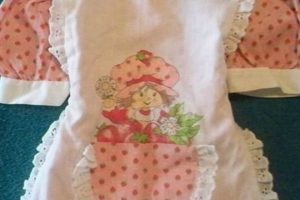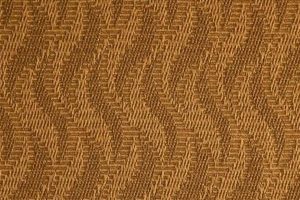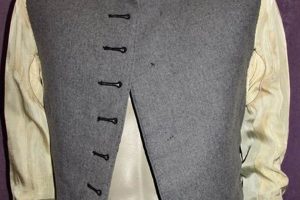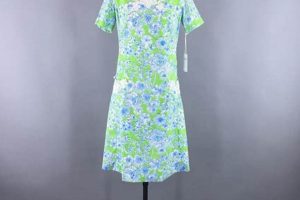Apparel featuring characters and designs from the Walt Disney Company’s earlier eras, typically pre-dating the 1990s, falls under the description of collectible Disney attire. These items may include t-shirts, sweatshirts, dresses, or accessories adorned with classic characters like Mickey Mouse, Donald Duck, and Goofy in designs characteristic of their respective periods. An example is a 1970s ringer tee displaying a screen-printed image of Mickey Mouse in his classic pie-eyed design.
Such nostalgic garments possess significance due to their connection with popular culture history and the enduring appeal of Disney characters. Their value stems from rarity, design aesthetics specific to certain decades, and their representation of childhood memories for many. The appeal lies in their embodiment of a bygone era and the tangible link they provide to the companys legacy.
The subsequent discussion will delve into avenues for acquiring these sought-after items, factors influencing their valuation, and preservation techniques to maintain their condition and historical integrity.
Essential Insights for Acquiring Collectible Disney Apparel
The following guidelines offer critical advice for those interested in sourcing and preserving garments from Disney’s past.
Tip 1: Research Authenticity Indicators: Examine labels, tags, and construction techniques that are consistent with the purported era. Familiarity with licensing agreements and trademark characteristics helps distinguish genuine articles from reproductions.
Tip 2: Assess Condition Diligently: Carefully evaluate the garment for staining, discoloration, holes, or fabric deterioration. Minor flaws may be acceptable, but significant damage will detract from value.
Tip 3: Understand Rarity and Demand: Certain characters, designs, or specific production years command higher prices. Monitor auction sites and collector forums to gauge current market trends.
Tip 4: Scrutinize Graphics and Prints: Authentic vintage prints often exhibit slight imperfections or fading, which can be indicative of age. Modern printing techniques are typically too precise to replicate the look of older methods.
Tip 5: Consider Storage and Display: Protect against light, moisture, and pests. Acid-free tissue paper and archival storage containers are recommended for preservation.
Tip 6: Document Provenance Where Possible: Any documentation, such as purchase receipts or photographs of the garment in use, can enhance its collectibility and value.
Tip 7: Seek Expert Appraisals: For high-value pieces, consulting with a professional appraiser experienced in vintage clothing can provide accurate valuation and authentication.
Implementing these strategies will facilitate informed acquisition and responsible preservation of these historically significant items.
The final segment of this article will summarize key considerations for those engaging with garments from the Walt Disney Company’s earlier eras.
1. Authenticity
The term authenticity, when applied to apparel featuring designs and characters from Walt Disney’s historical periods, denotes verifiable genuineness, distinguishing original items from reproductions or imitations. Establishing provenance involves meticulous examination of manufacturing labels, construction techniques, and specific artistic characteristics of the purported era. For instance, a screen-printed image of Mickey Mouse from the 1930s, executed with printing methods typical of that time, provides an indicator of authenticity; modern digital printing techniques produce a different visual effect. The failure to establish authenticity renders the item a reproduction, thereby significantly diminishing its collector value.
A primary consequence of lacking verifiable authenticity is a devaluation of the item within the collector market. A garment promoted as originating from the 1960s but exhibiting manufacturing inconsistencies with production methods of that time (e.g., modern synthetic fabric blends where only natural fibers were prevalent) casts doubt on its legitimacy. Determining genuineness therefore involves careful comparative analysis. Accessing databases of licensing agreements, historical records of Disney’s merchandising partnerships, and consulting with experts in vintage clothing can assist in this process. The presence of a Walt Disney Productions copyright symbol, consistent with the period, serves as a positive authentication marker.
In summary, authenticity serves as a cornerstone for valuation within the realm of collectible Disney attire. The practical significance of establishing genuineness lies in protecting buyers from fraud, preserving the historical integrity of the items, and ensuring accurate appraisal. Challenges in verifying authenticity include the proliferation of sophisticated reproductions and the deterioration of original garments over time. Understanding these aspects is crucial for responsible engagement within the collectors’ market and ensures the long-term preservation of these historical artifacts.
2. Rarity
In the context of apparel from the Walt Disney Company’s earlier years, rarity constitutes a primary determinant of value and collectibility. The scarcity of a particular garment, whether due to limited production runs, unique designs, or historical circumstances, significantly impacts its desirability among collectors and enthusiasts.
- Limited Production Runs
Garments manufactured in small quantities or for specific events exhibit heightened rarity. Examples include employee-exclusive merchandise, items produced for limited-time promotional campaigns, or clothing created solely for cast members at Disney theme parks. The fewer units produced initially, the greater the scarcity and potential value in the secondary market.
- Unique Character Designs
Apparel featuring atypical or unconventional character depictions adds to rarity. Items showcasing early character iterations, experimental designs, or collaborations with specific artists hold increased interest. For instance, a t-shirt displaying Mickey Mouse in a design vastly different from his standard appearance is likely to be more sought-after than a widely available, conventional design.
- Historical Circumstances
Garments associated with significant events in Disney’s history, such as film premieres, park openings, or anniversaries, often achieve rarity due to limited distribution. Apparel commemorating the opening of Disneyland in 1955, for example, represents a tangible connection to a pivotal moment, making it more desirable to collectors seeking items with historical significance.
- Material Scarcity and Unique Prints
Vintage apparel created with materials or printing techniques no longer in common use contributes to the item’s scarcity. Consider shirts made of a specific cotton blend that is no longer produced or printed using a specific screen-printing process. These factors make the shirts harder to find, as they stand out from modern-produced items.
The interplay between limited availability and the sustained demand for nostalgic representations of Disney’s characters and legacy underscores the critical role rarity plays in determining the value of collectible apparel. Recognizing the factors contributing to scarcity allows enthusiasts to strategically acquire and preserve pieces that hold both historical and financial significance.
3. Condition
The physical condition of antique Disney attire constitutes a pivotal determinant in its market valuation and desirability among collectors. Garments exhibiting superior preservation command a premium due to their historical integrity and visual appeal, while those marred by significant flaws experience a corresponding reduction in value.
- Fabric Integrity and Deterioration
The state of the fabric itself is paramount. Degradation, manifested as thinning, fraying, or tearing, directly diminishes the garment’s worth. Natural fibers, common in older Disney apparel, are susceptible to damage from light, moisture, and pests. Items exhibiting significant deterioration, such as extensive moth damage or complete disintegration of seams, are generally less desirable to collectors.
- Staining and Discoloration
The presence of stains or discoloration, resulting from age, improper storage, or exposure to contaminants, negatively impacts the item’s aesthetic and value. Yellowing of white fabrics, common in older garments, or the presence of stains from spills or environmental factors, detracts from the garment’s overall appeal and historical accuracy. Severe or irreversible staining significantly reduces the item’s collectibility.
- Graphic Fading and Cracking
The integrity of the graphic prints adorning the apparel is a crucial aspect of condition. Fading, cracking, or peeling of screen-printed images diminishes the visual impact and authenticity of the item. While some degree of wear is expected in older garments, excessive damage to the graphics reduces the garment’s value and appeal to collectors. The clarity and vibrancy of the graphic are directly correlated with its market price.
- Structural Issues and Alterations
Alterations or structural damage, such as missing buttons, broken zippers, or poorly executed repairs, detract from the garment’s originality and value. Modifications made to the garment’s original design, even if intended to improve fit, compromise its historical accuracy and desirability. The presence of intact original components and the absence of significant alterations are indicative of superior condition.
The assessment of physical condition necessitates meticulous examination and a comprehensive understanding of the materials and manufacturing techniques employed during the garments’ production era. Preserving items in climate-controlled environments, utilizing archival storage methods, and minimizing handling can mitigate further deterioration and maintain their historical and monetary value.
4. Era
The temporal period in which apparel featuring Walt Disney Company characters and designs was manufactured constitutes a foundational element in defining it as “vintage.” The era dictates the stylistic conventions, materials utilized, and the specific character iterations prevalent in the clothing. Consequently, the era profoundly impacts the item’s historical relevance, aesthetic appeal, and collector value. The 1930s, for example, saw the emergence of Mickey Mouse in his pie-eyed form, rendered on clothing crafted from natural fibers like cotton and wool. A garment showcasing this design and material composition demonstrably connects to that specific era, enhancing its authenticity and historical significance.
Identifying the correct era demands meticulous attention to detail, including an understanding of prevalent fashion trends, manufacturing techniques, and the evolution of Disney characters over time. For instance, the introduction of synthetic fabrics in the 1960s directly affected the composition of apparel, a detail that serves as a critical marker for dating items from that period. A Disney t-shirt utilizing polyester blends, therefore, cannot be accurately categorized as originating from the pre-1960s era. Discrepancies between the purported era and tangible characteristics undermine authenticity and diminish the item’s value within the collector market. Practical application of this understanding involves thorough examination of labels, materials, and printing methods.
In summary, the era serves as an indispensable criterion in the assessment and categorization of collectible Disney apparel. Recognizing the distinct features associated with each period allows for accurate identification, facilitates appropriate valuation, and ensures the preservation of these cultural artifacts. Challenges arise from the potential for misrepresentation and the difficulty in definitively dating items lacking clear markings or historical documentation. Nevertheless, a rigorous approach to era identification remains central to maintaining the integrity and value of vintage Disney clothing.
5. Design
The aesthetic design inherent in clothing items directly impacts their classification and valuation within the realm of vintage Disney apparel. Designs reflecting specific artistic movements, character portrayals representative of defined periods, and the overall stylistic choices contribute significantly to an item’s collectibility. For example, a 1950s Disney dress featuring a full skirt and a vibrant print of Snow White characters embodies the era’s characteristic fashion and artistic sensibilities, making it a highly desirable item among collectors. A poorly designed or generic item, regardless of its age, fails to capture the same historical or aesthetic significance.
The importance of design manifests in several key areas. It serves as a primary indicator of authenticity, allowing for the differentiation between original vintage pieces and modern reproductions. Specific graphic styles, such as the hand-drawn animation cels replicated on 1930s-era garments, are difficult to replicate with contemporary printing techniques, thus making the original designs uniquely valuable. Furthermore, design informs the overall appeal of the item, impacting its wearability and display value. A well-preserved design, showcasing iconic characters or motifs, holds intrinsic aesthetic value, making it a collectible piece of art as much as a functional garment. A practical understanding of these elements assists in informed purchasing decisions and the accurate assessment of historical value.
In summary, design serves as an essential element in understanding and appreciating antique Disney apparel. The distinctive styles, character representations, and artistic expressions inherent in these garments provide a tangible link to specific historical periods and cultural trends. While challenges exist in accurately attributing designs and verifying their originality, a keen awareness of design principles is critical for both collectors and historians seeking to preserve these pieces of cultural heritage. The absence of noteworthy design diminishes the items historical worth.
6. Licensing
The presence and characteristics of licensing agreements are critical determinants in authenticating and valuing Disney apparel from past eras. These agreements established the legal framework under which third-party manufacturers could produce merchandise featuring copyrighted characters and designs. Understanding the evolution of these licensing practices provides essential context for assessing the legitimacy and historical significance of garments.
- Trademark Identification and Copyright Notices
The presence of registered trademarks and copyright notices, such as ” Walt Disney Productions,” serves as a primary indicator of licensed merchandise. The specific wording, font, and placement of these marks often correlate with specific periods. Examining these details aids in dating and authenticating the item. For example, the absence of a copyright notice on a garment purported to be from the 1950s raises significant concerns regarding its legitimacy.
- Manufacturer Identification and Collaboration Details
Licensing agreements typically stipulated that the manufacturer’s name or logo be prominently displayed on the garment, often on a label or tag. Researching these manufacturers and their known partnerships with Disney helps to verify the item’s provenance. Some manufacturers specialized in specific types of apparel, such as children’s clothing or character-themed accessories. Knowing this history further enhances authentication efforts. A garment bearing the label of a company known to have held a Disney license during a particular period lends credibility to its claim of vintage status.
- Quality Control and Design Approvals
Licensing agreements frequently included provisions for quality control and design approvals by Disney. These provisions ensured that the merchandise met specific standards for character portrayal, color accuracy, and overall aesthetic quality. Evidence of attention to detail, consistent with Disney’s standards, suggests a higher likelihood of licensed status. For instance, a garment featuring characters accurately rendered in their classic style, with colors matching Disney’s archival references, points toward compliance with licensing requirements.
- Geographic Restrictions and Market Segmentation
Some licensing agreements were geographically restricted, granting exclusive rights to manufacturers within specific regions. Identifying these regional variations helps to understand the distribution patterns of vintage Disney apparel. Certain manufacturers may have focused on specific market segments, such as theme park souvenirs or mail-order merchandise. Knowing these market distinctions assists in evaluating the rarity and collectibility of particular items. A garment labeled as “Exclusively for Disneyland” suggests a limited production run and targeted distribution, potentially increasing its value among collectors.
The historical framework of Disney’s licensing practices profoundly impacts the value and authenticity of garments from its past. Comprehending these agreements empowers collectors to make informed purchasing decisions and ensures the preservation of historically significant artifacts. A lack of understanding these nuances leads to misidentification and devaluation of the items.
Frequently Asked Questions
The following section addresses common inquiries regarding vintage Disney apparel, providing clarity on key aspects of collecting, authentication, and care.
Question 1: What criteria define an item as “vintage Disney clothing”?
Generally, items manufactured at least 20-25 years prior to the present day, featuring Disney characters or themes, and exhibiting manufacturing techniques consistent with the period, qualify as vintage. However, collectibility also depends on rarity, condition, and design appeal.
Question 2: How can the authenticity of garments be verified?
Authentication involves examining labels, tags, and construction techniques for consistency with known manufacturing practices of the purported era. Comparing details against established databases of licensed manufacturers and design trademarks provides additional validation. Seeking expert appraisal can be beneficial for high-value items.
Question 3: What factors influence the valuation of collectible Disney apparel?
Valuation is determined by a combination of factors, including rarity, condition, design aesthetics, historical significance, and the presence of original tags or documentation. Market demand and the item’s overall appeal to collectors also play a significant role. Items in pristine condition and featuring rare designs command higher prices.
Question 4: What are the most common types of damage observed in older garments and how can they be prevented?
Common forms of damage include staining, discoloration, fabric deterioration (thinning, fraying), and graphic fading. Prevention involves proper storage in climate-controlled environments, utilizing acid-free tissue paper and archival garment bags. Avoid direct sunlight and excessive handling. Professional cleaning may be necessary for soiled items.
Question 5: Where can authentic garments typically be sourced?
Authentic vintage Disney attire may be found at estate sales, antique shops, online auction sites, and specialized vintage clothing stores. Exercising caution and thoroughly verifying the item’s authenticity before purchase is crucial. Reputable dealers with proven expertise can provide assurance and minimize the risk of acquiring reproductions.
Question 6: Are reproductions of Disney clothing considered collectible?
While reproductions may hold some appeal for casual enthusiasts, they generally lack the historical and monetary value associated with original vintage pieces. Reproductions are typically produced in larger quantities and lack the unique characteristics that make authentic vintage garments desirable to collectors.
In summary, engaging with collectible apparel requires careful research, meticulous assessment, and a comprehensive understanding of historical context. Proper preservation ensures these cultural artifacts retain their value and historical integrity for future generations.
The next section explores case studies of particularly valuable and historically significant examples from the realm of vintage Disney clothing.
Conclusion
The preceding analysis has explored diverse facets of the realm of vintage Disney clothing, encompassing authentication methods, valuation determinants, and preservation techniques. A thorough understanding of manufacturing processes, design evolution, and licensing agreements specific to various eras is essential for responsible collecting. Scrutinizing condition, recognizing rarity, and accurately dating items significantly mitigate the risk of misidentification and financial loss.
The enduring appeal of vintage Disney clothing lies in its tangible connection to the companys storied history and its capacity to evoke nostalgia. Continuing research, informed acquisition practices, and diligent preservation efforts will ensure that these garments remain accessible as artifacts of cultural and historical importance for future generations. Therefore, collectors and enthusiasts are encouraged to approach this subject with meticulous care and a commitment to preserving these valuable pieces of the past.







